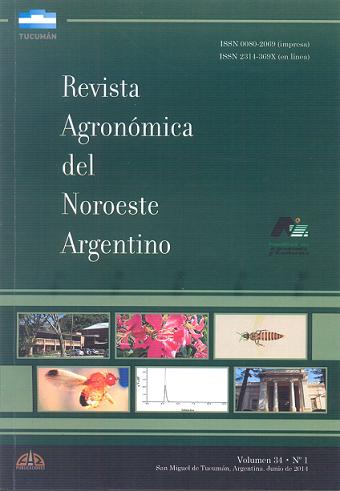Ver ítem
- xmlui.general.dspace_homeCentros Regionales y EEAsCentro Regional Tucumán - Santiago del EsteroEEA FamailláArtículos científicosxmlui.ArtifactBrowser.ItemViewer.trail
- Inicio
- Centros Regionales y EEAs
- Centro Regional Tucumán - Santiago del Estero
- EEA Famaillá
- Artículos científicos
- Ver ítem
Relevamiento de ácaros fitoseidos (Acari: Phytoseiidae) presentes en dos plantaciones cítricas y en su vegetación asociada en Tucumán, Argentina = Survey of phytoseiid mites (Acari: Phytoseiidae) found in two citrus orchards and their associated vegetation in Tucumán, Argentina
Resumen
La familia Phytoseiidae constituye, dentro de los ácaros depredadores, una de las familias que genera importantes beneficios económicos en cultivos debido a que varias especies se alimentan de insectos y ácaros plagas. En Argentina, se realizaron relevamientos de fitoseidos presentes en agroecosistemas cítricos de las regiones NOA y NEA, cuyos últimos registros fueron realizados en el año 2008. Por lo tanto, el objetivo de este trabajo fue actualizar la
[ver mas...]
La familia Phytoseiidae constituye, dentro de los ácaros depredadores, una de las familias que genera importantes beneficios económicos en cultivos debido a que varias especies se alimentan de insectos y ácaros plagas. En Argentina, se realizaron relevamientos de fitoseidos presentes en agroecosistemas cítricos de las regiones NOA y NEA, cuyos últimos registros fueron realizados en el año 2008. Por lo tanto, el objetivo de este trabajo fue actualizar la diversidad de ácaros fitoseidos en plantaciones cítricas y su respectiva vegetación circundante en la localidad de El Manantial y Famaillá, Tucumán. El estudio se llevó a cabo en parcelas experimentales de ambas localidades implantadas con limonero, naranjo, mandarino y pomelo. Se recolectaron muestras de hojas, flores y frutos de los cítricos y de vegetación espontánea asociada a ellos. En cítricos, se identificaron los siguientes ácaros Euseius concordis y Amblyseuis herbicolus ya citados. Asimismo, se amplía el registro de nuevas especies: Euseius fructicolus, Galendromus annectens, Typhlodromalus peregrinus, Neoseiulus tunus, Graminaseius sp. group bufortus, Metaseiulus (Metaseiulus) sp. group cornus y Typhlodromus (Anthoseius) transvaalensis. En cuanto a la vegetación espontánea, se determinaron los ácaros A.
herbicolus, E. concordis, Phytoseiulus longipes y Typhlodromalus peregrinus que ya habían sido previamente registrados y se amplió el registro de nuevas especies: Graminaseius sp. group bufortus y Typhlodromips sp. group lugubris. Este último fue el único detectado exclusivamente sobre este tipo de vegetación.
[Cerrar]
The Phytoseiidae family is among the predatory mites, one of the most economically important families because many of their species feed on insects and mites pests. In Argentina, phytoseid surveys were carried out in citrus orchards of the NOA and NEA regions, however the latest records are from 2008. Therefore, the objective of this work is to update the diversity of phytoseiid mites in citrus plantations and their respective surrounding vegetation in
[ver mas...]
The Phytoseiidae family is among the predatory mites, one of the most economically important families because many of their species feed on insects and mites pests. In Argentina, phytoseid surveys were carried out in citrus orchards of the NOA and NEA regions, however the latest records are from 2008. Therefore, the objective of this work is to update the diversity of phytoseiid mites in citrus plantations and their respective surrounding vegetation in the locality of El Manantial and Famaillá, Tucumán. The study was carried out in experimental plots of both localities implanted with lemon, orange, mandarin and grapefruit. Samples of leaves, flowers and fruits of the citrus fruits and vegetation associated were extracted. In citrus, Euseius concordis and Amblyseuis herbicolus, previously mentioned, were identified. However, the registration of new species is widened: Euseius fructicolus, Galendromus annectens, Typhlodromalus peregrinus, Neoseiulus tunus, Graminaseius gr. esp. bufortus, Metaseiulus (Metaseiulus) gr. esp. cornus and Typhlodromus (Anthoseius) transvaalensis. In the spontaneous vegetation were identified A. herbicolus, E. concordis, Phytoseiulus longipes and Typhlodromalus peregrinus already registered previously. Graminaseius gr.esp bufortus and Typhlodromips gr. esp. lugubris are mentioned for the first time. Typhlodromips gr. esp. lugubris was the
only one detected exclusively on this type of vegetation.
[Cerrar]

Autor
Carrizo, Beatriz Noemi;
Macián, Ana Josefina;
Sopena, Yésica Noelia;
Fuente
Revista agronómica del noroeste argentino 38 (1) : 51-56 (jun . 2018)
Fecha
2018-06
Editorial
Facultad de Agronomía y Zootecnia, Universidad Nacional de Tucumán
ISSN
0080-2069
2314-369X
2314-369X
Formato
pdf
Tipo de documento
artículo
Palabras Claves
Derechos de acceso
Abierto
 Excepto donde se diga explicitamente, este item se publica bajo la siguiente descripción: Creative Commons Attribution-NonCommercial-ShareAlike 2.5 Unported (CC BY-NC-SA 2.5)
Excepto donde se diga explicitamente, este item se publica bajo la siguiente descripción: Creative Commons Attribution-NonCommercial-ShareAlike 2.5 Unported (CC BY-NC-SA 2.5)


